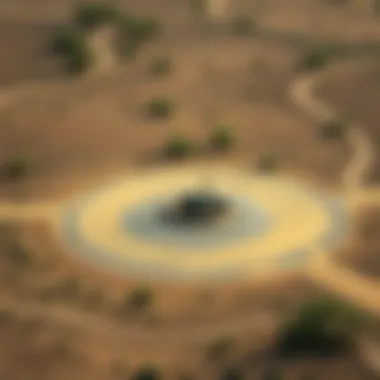Addressing the Challenges of Dry Well Issues


Overview of the Topic
Navigating the complexities of dry wells is vital, particularly as the demand for water resources surges. Wells are often considered lifelines for communities, significantly contributing to both residential and agricultural needs. When these sources dry up, the implications can ripple through local ecosystems and economies in unexpected ways.
In many regions, including arid and semi-arid landscapes, understanding the significance of well management is crucial. As ground water tables lower due to various human activities, the sustainability of these water sources hangs in the balance. The examination of this subject is not just a technical matter; it’s a call to action for responsible stewardship of our natural resources.
Current Status and Challenges
The current landscape of well management reveals a growing crisis. Across the globe, many communities are grappling with the depletion of their wells, often brought on by over-extraction of groundwater and climate change. Unfortunately, these challenges don’t just rest on environmental shoulders; they weigh heavily on the community members who rely on this resource.
- Decreasing Groundwater Levels: Unsustainable agricultural practices and increased urbanization have led to significant drops in groundwater levels. Research shows that regions like the Central Valley in California face severe dry well problems due to excessive water usage.
- Infrastructure Issues: Many existing well systems are outdated; their capacity does not match the present-day demand. Poor maintenance only exacerbates the problem, leaving communities to face water scarcity.
- Environmental Impact: Dry wells don't just signal human loss; they disrupt ecosystems. Flora and fauna that depend on ground water sources start to wither, leading to biodiversity loss.
"Water is the foundation of life. When wells run dry, both people and nature suffer profoundly."
Sustainable Solutions
Addressing the challenges faced by dry wells is undeniably complex. However, several innovative and sustainable solutions have emerged that can mitigate these issues.
- Rainwater Harvesting: This method is increasingly being adopted by communities to supplement well water. Collecting and storing rainwater can help recharge aquifers and lessen reliance on over-extracted groundwater.
- Smart Agriculture: Techniques such as drip irrigation and soil moisture monitoring can significantly reduce the amount of water consumed in farming. These practices help preserve groundwater without compromising agricultural yields.
- Recharging Aquifers: Encouraging policies for aquifer recharge through managed aquifer recharge (MAR) methods has proven effective in several regions. This allows water to enter the ground in a controlled manner, replenishing wells naturally.
Successful case studies illustrate the effectiveness of these methods. For instance, the city of Austin, Texas, has implemented rainwater harvesting systems that have not only conserved water but also improved local water quality.
Impact and Importance
The impact of dry wells extends far beyond immediate water shortages. It touches upon public health, local economies, and even social stability. Communities facing dry well problems often struggle with:
- Public Health Risks: Water scarcity can lead to the use of unsafe water sources, increasing the risk of disease outbreaks.
- Economic Strain: Farmers may be unable to sustain crops, leading to increased food prices and diminished local economies.
- Social Unrest: Water scarcity has historically been a catalyst for conflict, particularly in regions where water is already a contested resource.
Conservation efforts are paramount in safeguarding both current and future water needs. By fostering a culture of sustainability and awareness around water usage, communities can protect their water resources effectively. Collaboration among local authorities, environmental groups, and the public can create robust solutions that not only preserve water today but ensure its availability for tomorrow, thus contributing positively to overall environmental health.
Understanding Dry Wells
Grasping the concept of dry wells is essential when navigating the waters of environmental resource management. Dry wells, in their core function, serve as critical components of our water distribution systems. Yet, as seasons shift and climates fluctuate, these wells can fall into a cycle of dryness. Understanding why this happens, and the implications it carries for a community and the ecosystem at large, can guide effective action plans and preventive measures. With this underpinning of knowledge, various stakeholders—be it conservationists, local governments, or everyday residents—can engage in more informed discussions about water usage and sustainability.
Definition and Function
A dry well, simply put, is designed to manage excess stormwater runoff and typically functions by allowing water to seep into the ground. However, when we talk about "dry wells" in the context of this article, we refer not just to this excessive management; we concentrate on those wells—be it for domestic use or agricultural reliance—that have stopped yielding water. This cessation of water flow can arise from various causes, from natural climatic shifts to human actions like over-extraction.
In practical terms, dry wells serve a crucial role in maintaining local water cycles, allowing some areas to recharge groundwater over time. They are often the unsung heroes of water management, operating behind the scenes to cycle and store water. Yet the reason behind their dryness merits greater exploration, as it paves the way to understanding the broader challenges tied into environmental stewardship.
Importance in Water Management
Effective water management stands as a cornerstone of ecological sustainability. Dry wells are a litmus test for how well a community utilizes and conserves its water resources. When these wells run dry, it sends a clear signal that something is amiss in the larger water ecosystem. The implications are numerous: threats to household water supplies, hardships for local farms, and significant environmental disturbances.
Recognizing this importance, various measures can be taken. For instance, reinforcing sustainable practices can help preserve groundwater levels, prolonging the efficacy of these wells. Engaging with local communities to raise awareness about conservation practices fosters a collective sense of responsibility. Furthermore, maintaining functional and healthy dry wells interlaces community engagement, regulatory adherence, and advanced water management strategies.
"Understanding dry wells encapsulates not just their operational dynamics but also the cultural and environmental footprints they leave behind."
By diving deeper into the significance of dry wells, we can unravel layers that expose the challenges and solutions that accompany this vital water resource.
Common Causes of Dry Wells
Understanding the common causes of dry wells is crucial for anyone involved in water management or situated in areas where reliance on well systems is significant. Knowing these causes not only helps in diagnosing issues but also in creating more sustainable practices to prevent such occurrences. By addressing these problems, water conservation is enhanced, and the risk of future dry wells can be significantly diminished.
Natural Cycles and Climate Factors
Natural cycles, such as seasonal changes and longer-term climate variability, can have a substantial impact on well performance. For example, during prolonged dry spells or droughts, the groundwater levels may recede lower than normal, leading to reduced water availability in wells.
Additionally, changes in rainfall patterns can exacerbate these conditions. Regions that typically rely on seasonal rains may find their wells drying faster than expected if those rains fail to materialize or if they arrive later in the year.
- Impact of Seasonal Changes: These cycles often lead to fluctuations in water table levels. Wells may appear dry one season and refill in another, creating a misleading sense of security.
- Long-term Climate Trends: Rising temperatures and changing weather patterns may cause long drought periods, stressing already fragile water systems. This may lead to inadequate recharge of aquifers, pushing well users into a state of worry.
To illustrate, a farmer depending on a well for irrigation might face dire consequences during a season of unexpected weather changes. Thus, monitoring local climate data and staying adaptable becomes a necessity for proactive water management.
Over-extraction of Water Resources


Over-extraction is another primary culprit behind dried-up wells. Drawing more water than can be naturally replenished creates a precarious situation. This scenario is a typical outcome when communities depend heavily on a single source for domestic or agricultural purposes.
- Understanding Water Demand: Population growth and increased agricultural activities often lead people to tap into underground resources more aggressively.
- Urbanization Contribution: Urban areas often binge on water resources without regard for sustainable usage, leading to tension between urban needs and natural capacity.
An illustrative example is the overuse in suburban areas where households rely solely on wells, while aquifer recharge is inadequate. Without strategies to limit usage, dry wells can emerge too frequently, putting local economies and ecosystems at risk. The demand for water must be balanced carefully with what nature can provide.
Geological Considerations
The geological characteristics of an area significantly influence well performance. Various rock types, soil composition, and structural features like fault lines dictate how water moves underground.
- Aquifer Variation: Some aquifers are inherently less productive, meaning that their capacity to supply water can fluctuate dramatically, especially in times of drought.
- Porosity and Permeability: The porosity of the geological material directly affects how much water it can hold. More porous rocks retain more water, whereas less porous materials can lead to less reliable well performance.
For instance, in regions where the geological layers consist of impermeable materials, applying too much pressure on the water table can cause the wells to dry up faster, leaving the local populace struggling to find alternative water sources. Drawing from studies presented in geological surveys can provide a roadmap for understanding these relationships and inform better well placement.
Understanding the interplay of natural, human, and geological factors is pivotal in addressing dry well problems, ensuring sustainable water management practices for the future.
Through an integrated approach considering all these aspects, communities can develop strategies to keep their wells productive and lessen the risks associated with dry wells. Each cause holds its significance, contributing collectively to the bigger picture of water resource management - a cause worth investing time and energy into.
Signs Indicating Dry Well Problems
Recognizing the signs of dry well problems is imperative for effective water management. These indicators often serve as the first alert to communities and property owners about potential changes in their water supply. Addressing these issues timely can prevent further complications that may arise from neglecting early warning signs.
Decreased Water Flow
One of the most apparent signs that a well is facing issues is a noticeable drop in water flow. When the tap barely produces even a trickle, it’s a sure-fire signal that something’s amiss. A variety of factors can contribute to lower flow rates, including prolonged drought conditions or excessive groundwater extraction. It can be likened to a car running low on fuel; it doesn't stop all at once but gradually starts sputtering.
Moreover, decreased water flow not only hampers daily domestic needs but can also disrupt irrigation schedules for farms. When farmers rely on a well for their crops, even minor fluctuations in water levels can lead to significant agricultural setbacks. Therefore, monitoring water flow should be a continuous practice for well users, ensuring they catch problems before they escalate.
Changes in Water Quality
Water quality can deteriorate for various reasons, ranging from contamination to changes in the geological conditions surrounding the well. If the water starts tasting different, or if there is an unusual color or smell – these can indicate serious issues that should not be ignored. The introduction of sediments or pollutants often leads to health risks, making water unsuitable for drinking or irrigation.
Communities should test their water regularly. Some even say, “an ounce of prevention is worth a pound of cure.” By keeping an eye on water quality, users can intervene early and possibly even avoid costly remediation processes.
“Why wait for the problem to knock at your door when you can keep it in check?”
Regular water testing, checking for pH levels and bacterial presence, helps in establishing a clear timeline of changes to the water chemical composition.
Physical Well Conditions
The structural integrity of a well is another critical indicator of its health. Signs such as cracks in the casing, rust, or even physical obstructions around the well site can articulate deeper issues. It's important to conduct visual inspections periodically to identify such complications. For instance, if a well casing appears to be sagging, it could indicate potential contamination or structural failure, which could ultimately lead to an unsustainable water supply.
In addition, the wellhead should be maintained to prevent debris or foreign materials from entering the system. This is the first line of defense against contamination. So, keeping the physical space around the well tidy and examining the construction regularly is vital in preserving well function.
Consequences of Dry Wells
The ramifications of dry wells extend far beyond the immediate loss of water access. They touch upon various facets of daily life, including health, agriculture, and environmental sustainability. Understanding these repercussions is crucial for anyone involved in water resource management, from policymakers to everyday citizens reliant on well water. Dry wells pose a significant challenge that, if ignored, can escalate into severe socio-economic dynamics. Hence, analyzing these consequences is not merely an academic exercise; it is fundamental for fostering a resilient approach to water conservation.
Impact on Domestic Water Supply
When a household well starts to dry up, the first noticeable impact is on domestic water supply. Families often find their taps running dry, leading to immediate discomfort and more importantly, health concerns. This situation cultivates a dependency on substitute water sources—be it municipal supply, bottled water, or even costly water delivery services.
The costs associated with such shifts can be staggering. Residents in dry well zones may face:
- Increased monthly bills due to reliance on alternative sources.
- The expense of drilling new wells or upgrading existing systems, which can further strain budgets.
Moreover, when water becomes scarce, it can lead to conflicts within communities as access becomes inequitable. Families that can't afford alternative solutions may suffer disproportionately, raising critical questions about social justice in water access.
Agricultural Challenges
For farmers, a dry well spells disaster. Agriculture relies heavily on consistent water supply for irrigation. When wells fail, crop yields plummet, directly affecting food availability and economic stability in farming communities. The inability to irrigate leads to:
- Reduced harvest size, which can drive up food prices and consequently affect local economies.
- Potential losses in livestock health, as animals depend on regular access to water for drinking and bathing.
Farmers facing dry wells often seek alternative irrigation sources, which can lead to over-extraction from nearby rivers or lakes, perpetuating a cycle of water shortages in the larger ecosystem. This not only threatens immediate agricultural sustainability but can also have long-term consequences on regional food security.


Environmental Repercussions
Dry wells have serious implications for the environment as well. When groundwater levels dip, the surrounding ecosystems face tremendous stress. Aquifers can take decades to replenish, and in the interim, several environmental issues can emerge:
- Habitat destruction is a critical concern. Aquatic species that depend on steady water levels can experience population declines, leading to a collapse in local biodiversity.
- Alterations in the landscape can trigger soil erosion, where land once buffered by plants now becomes susceptible to weathering.
- Changes in groundwater patterns can even affect street-level drainage and increase the risk of flooding in nearby areas, creating yet another layer of complexity in managing water resources.
A dry well is not just a personal inconvenience; it ripples through the community, affecting food supply, economic stability, and the natural environment.
In summary, the consequences of dry wells encompass a wide array of challenges that affect individuals, communities, and ecosystems alike. It’s essential to delve deeper into these implications to design effective strategies for sustainable water management.
Preventative Measures
Addressing the challenge of dry wells requires a proactive approach. This section underscores the significant need for preventative measures to ensure the sustainable management of water resources. By focusing on specific strategies, these measures aim to reduce the risk of dry wells and optimize water conservation efforts. Understanding these strategies is crucial for environment-focused individuals and organizations who aim to preserve vital water supplies.
Sustainable Water Resource Management
Sustainable water resource management might sound like one of those buzzword phrases tossed around at environmental conferences, but it carries real weight. Simply put, it's about using water resources wisely. Imagine a balancing act—on one side, we have the essential needs of communities, agriculture, and industry; on the other, the need to maintain ecological integrity. When we strike that balance, we keep wells productive and natural ecosystems thriving.
This management involves practicing responsible extraction. Instead of pumping water until the well runs dry, communities can adopt techniques such as rainwater harvesting and groundwater recharge. By allowing the aquifers to rest and replenish, we can effectively extend the lifespan of our wells. Additionally, stakeholder education is paramount here. Not everyone knows the long-term benefits of switching to more sustainable practices, but with dedicated outreach programs, awareness can be raised immensely.
Regular Well Maintenance Practices
Keeping a close eye on the well and implementing regular maintenance practices cannot be overstated. Much like a car needs an oil change now and then, wells require attention too. Regular inspections can help detect issues before they snowball into significant problems.
Key Maintenance Steps:
- Check for leaks: A small drip might not seem like a big deal, but it can signify deeper issues.
- Assess water levels: Knowing your current water levels allows for forecasting and proactive measures.
- Clean the well casing: It’s essential to maintain cleanliness to avoid contamination and ensure optimal flow.
- Test water quality regularly: A simple test can reveal harmful contaminants that might compromise safety.
Implementing these practices fosters a longer life for wells and ensures continuous access to clean water.
Monitoring Natural Water Levels
Finally, monitoring natural water levels is vital in tackling dry well issues before they manifest. Awareness is key. By understanding the seasonal fluctuations of water levels, communities can plan for dry spells more effectively. Tools such as piezometers and flow meters provide crucial data—in essence, they're the canaries in the coal mine when it comes to groundwater trends.
Moreover, regular monitoring allows for informed decision-making. When water levels begin to drop, it’s a signal for communities to shift their water usage habits. Instead of hitting the panic button when a drought hits, communities equipped with real-time data can adjust their strategies and allocate resources accordingly. This ensures that we stay one step ahead of potential crises.
**"An ounce of prevention is worth a pound of cure." **
In the end, adopting these three intricate layers of preventative measures can significantly mitigate the challenges posed by dry wells, ensure a reliable water supply, and maintain the delicate balance of our ecosystems. By thoroughly understanding and employing sustainable management, regular maintenance, and diligent monitoring, communities can navigate challenges effectively and promote resilient water systems for future generations.
Technological Solutions
In today’s world, the challenges posed by dry wells have called for innovative approaches to tackle these issues sustainably and effectively. Technological solutions provide essential tools and techniques that not only identify the problems but also help in mitigating them. These advancements save water, improve efficiency in water management, and ultimately protect vital water resources.
Advanced Drilling Techniques
The methods of drilling have seen significant progress in recent years, adjusting to the pressing need for deeper and more resilient well systems. Advanced drilling techniques, such as rotary drilling or horizontal directional drilling, can reach aquifers that were previously inaccessible, a crucial factor in regions struggling with water scarcity.
Not only do these methods enhance water yields, but they also reduce disturbances to the surrounding environment. Drilling deeper means tapping into more sustainable sources of groundwater. For instance, rotary drilling uses a rotating drill bit, allowing it to penetrate rock more efficiently than traditional methods.
However, while these techniques offer great promise, they come with considerations. For one, their cost can be prohibitive for certain communities, especially small farming operations. Moreover, the environmental impact has to be carefully monitored to avoid unintentional damage to ecosystems.
"Understanding the balance between technology and nature is essential to water sustainability." - Expert in Hydrology
Efficient Water Conservation Technologies
Innovative water conservation technologies have emerged as a beacon of hope for addressing dry well problems. These tools are designed to maximize the amount of water retained and reduce wastage. Techniques such as rainwater harvesting systems and smart irrigation are examples of how technology can play a pivotal role in ensuring water availability.
Rainwater harvesting systems collect and store rainwater for various uses, significantly decreasing reliance on watered wells. Smart irrigation systems, on the other hand, utilize sensor technology to assess soil moisture, ensuring that water is applied only when necessary, thereby promoting conservation.
Moreover, the integration of data analytics can offer insights into water usage patterns, subsequently helping to pinpoint areas for improvement. When communities adopt these technologies, it is not just a step toward conserving water; it embodies a cultural shift toward responsible resource management.
In summary, today’s technological advancements in drilling and conservation present vital opportunities for addressing dry well issues. Adopting these solutions involves not only embracing innovation but also cultivating an awareness and responsibility towards sustainable water management practices.
Case Studies and Examples


Understanding practical implications and resolutions for dry well issues is crucial. By examining specific cases, we can identify successful strategies and learn from failures. These case studies exhibit how different regions or sectors have approached the pressing challenges associated with dry wells. They paint a clear picture of the interplay between community practices, technological advances, and policy frameworks in managing water resources effectively.
Municipal Water Systems and Dry Wells
Municipalities face unique challenges when dealing with dry wells. Consider a city like Phoenix, Arizona, known for its arid climate and diminishing groundwater supplies. In response to persistent dryness, city planners adopted a strategy merging water recycling with stormwater management. The town installed robust infrastructure to capture rainwater, which, though infrequent, adds significantly to their water supply. This approach not only helps to recharge wells but also mitigates flooding during rare rain events.
The case of the Greater Los Angeles area reflects how urgent action can make a significant difference. Faced with increasing well failures, the city revamped its public outreach and education campaigns. Through partnerships with local organizations, they educated residents about water conservation practices—aiming at reducing individual usage. Results showed a notable decrease in demand for well water, allowing for more sustainable extraction practices. Furthermore, strategic drilling into aquifers has resurfaced interest in early 20th-century engineering, blending vintage wisdom with modern needs.
Some practical points that can be inferred from these examples include:
- The effectiveness of integrated water management strategies in mitigating dry well problems.
- The role of public engagement in promoting water conservation and sustainable usage.
- Emphasizing historical knowledge can uncover sustainable solutions in contemporary society.
Agricultural Practices in Drought-Prone Areas
Drought-prone areas such as the Central Valley in California provide other rich case studies. Farmers here spearheaded the adoption of drip irrigation, a technique that delivers water directly to the plant roots. This meticulously targeted approach not only conserves water but also ensures that existing wells are less likely to run dry. Rising concerns around water amount sparked the development of new crops that require less water. An example is the increase in production of salt-tolerant crops, allowing farmers to adapt to their environment whilst still maintaining yields.
Furthermore, organizations such as the Valley Water Board implemented flexible water allocation policies. This practice allows for seasonal adjustments based on real-time environmental metrics. Farmers are encouraged to share resources through cooperative models, allowing less water-intensive operations to benefit from successes in managing dry well impacts.
In these scenarios, we see that:
- Technology can provide innovative solutions to age-old problems.
- Collaboration among farmers, government agencies, and environmental groups is essential for long-term sustainability.
- Cultivating water-efficient practices in agriculture is a pressing need, especially in regions facing severe drought.
"The future of resource management relies heavily on adaptability and innovation."
Delving into these case studies not only sheds light on individual initiatives but also offers convergence points for a holistic approach to drought and dry well issues. By harnessing lessons learned and successful practices, communities can foster resilience against the growing water crisis.
Future Outlook on Dry Well Issues
The future outlook on dry well issues is paramount for effective water resource management. As climate variability continues to intensify, understanding these projected changes is crucial for devising sustainable solutions. Given the potential for more frequent droughts and shifting precipitation patterns, it is vital to remain ahead of the curve. Effective strategies will not only address immediate problems but will also lay the groundwork for resilient water management practices.
Predicted Climate Changes
Climate change presents a tangled web of challenges, particularly concerning hydrological cycles. Models predict increased temperatures, alteration in rainfall patterns, and more prolonged dry spells in many regions. For instance, the Upper Midwest of the United States might experience up to 30% less precipitation during the growing season. This reduction could exacerbate the strain on existing water resources, further increasing the incidence of dry wells.
Moreover, the potential rise in humidity could lead to increased evaporation rates. Therefore, even if rainfall remains steady, the effective water availability may dwindle. These shifts necessitate adapting our water allocation strategies, enhancing conservation efforts and rethinking usage standards.
Evolution of Water Management Policies
With the mounting pressure from climate change, water management policies must also evolve. Historically reactive, contemporary management approaches demand a more proactive stance, focusing not only on immediate water relief but also on long-term sustainability. This transition encompasses a variety of elements:
- Collaboration with Environmental Bodies: Partnerships among governmental bodies, environmental organizations, and communities will be vital in crafting downward effects on water resource management.
- Incorporating Technology: Incorporating advanced technology such as satellite data to monitor water resources can enable more timely and effective responses to emerging problems.
- Regulations on Water Use: Revising regulations to promote conservation, especially in agricultural sectors, can significantly mitigate the impacts of dry wells.
As these policies shift, the aim should be to strike a balance between meeting immediate community needs and safeguarding the resources for generations to come. Leveraging these changes will help cultivate a more sustainable relationship with our water systems, ultimately addressing the pressing dry well issues as they arise.
Collaborative Solutions and Community Involvement
The challenges posed by dry wells are not just a personal headache for homeowners; they extend to entire communities and ecosystems. When tackling such issues, it’s crucial to recognize the power of collaboration. Involving different stakeholders—residents, local organizations, and government bodies—can lead to more comprehensive solutions. Working together encourages a pooling of resources, knowledge, and efforts, making it easier to share best practices and create sustainable strategies for water management.
There are several advantages to fostering a collaborative approach:
- Resource Allocation: By combining efforts, communities can optimize their resources, both human and financial. Local organizations might have grants available that could support community initiatives on water management.
- Knowledge Sharing: Different stakeholders bring varied experiences that can contribute to a more nuanced understanding of the challenges and potential solutions. This collective wisdom helps shape more informed decisions.
- Community Engagement: Involving locals in the decision-making process fosters a sense of ownership. Individuals are more likely to invest in solutions when they feel personally connected to the effort.
In essence, when communities unite, they create a stronger front against the problems posed by dry wells.
Public Awareness Campaigns
Public awareness campaigns play a pivotal role in addressing dry well challenges. Such initiatives focus on educating the community about water conservation methods and the importance of regular well maintenance. Through effective communication strategies, these campaigns can raise awareness about the signs of drying up wells and encourage proactive measures.
A few tactics that are often successful in raising public consciousness include:
- Workshops and Seminars: Organizing local workshops helps provide firsthand knowledge on sustainable practices and the significance of preserving water resources.
- Social Media Engagement: Utilizing platforms like Facebook or Reddit can help disseminate information quickly and effectively, reaching a wider audience.
Public awareness isn’t just about making noise. It’s about creating a knowledgeable society that can advocate for sustainable practices over the long haul.
Incorporating visuals and emphasizing local narratives can further enhance the impact of these campaigns. Personal stories often resonate and can shift perspectives, motivating action in others.
Role of Local Organizations
Local organizations act as the backbone of community involvement in tackling dry well issues. These entities often comprise dedicated individuals who understand the unique challenges their community faces. They bring a wealth of local knowledge and can direct resources to where they’re most needed.
Such organizations typically engage with the community in various impactful ways:
- On-the-Ground Support: They may offer hands-on assistance for well maintenance and repairs or help set up water conservation systems, facilitating immediate improvements.
- Educational Resources: By producing informative materials or guides, local organizations empower residents with the knowledge needed to act independently in water management.
- Advocacy: These groups often serve as champions for better policies at broader governmental levels, voicing community concerns about water scarcity and advocating for sustainable practices.



